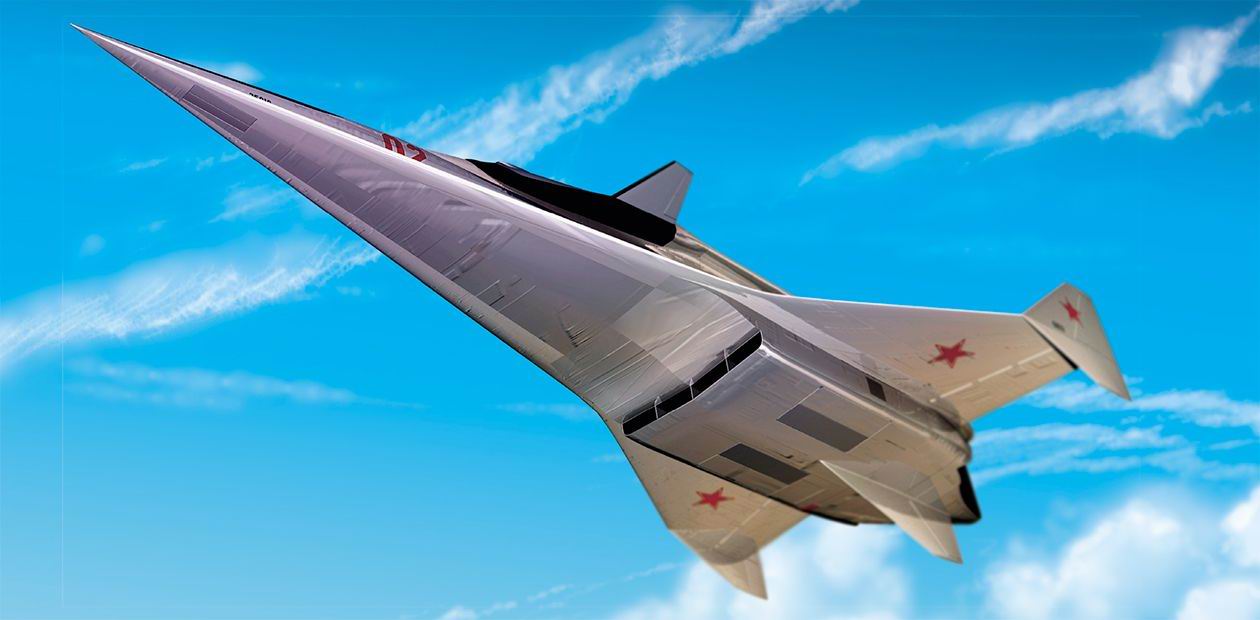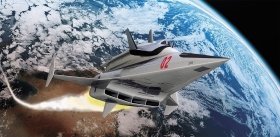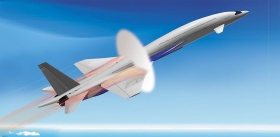Aerospace Plane
The eternal dream of humankind — people flying like birds — by the XXI century was replaced by a more advanced slogan — aircraft flying like rockets!
AEROSPACE PLANE
The first project of a scramjet-powered aerospace plane (1966, ussr)
In 1957, E. S. Shchetinkov put forward and substantiated the idea of creating an air-breathing engine with fuel burning in a supersonic flow in the combustion chamber (scramjet). Almost simultaneously investigation combustion in supersonic flows began in the USA. In 1966, the scramjet was considered for propulsion of an aerospace plane — a pioneering project of a single-stage aerospace transport vehicle implemented at the Research Institute No. 1 of the Ministry of Defense Engineering of the USSR (now the Keldysh Research Center), where Shchetinkov worked at that time. The marching powerplant of this aerospace plane was composed of a rocket engine, a ramjet, and a scramjet operating on liquid hydrogen; sequential operation of these engines made available the atmospheric flight of the craft up to a high hypersonic Mach number (М)*=20; after that, two high-altitude rocket engines were switched on, and the craft entered a near-Earth orbit. This was the beginning of the history of aerospace planes which can take off from conventional airfields, fly through the atmosphere, enter an orbit near the Earth, and return back to the ground.
The take-off weight of the aerospace plane was estimated to be 150—250 tons, and the payload was expected to be 6—11 tons
Development of space rockets was one of the most impressive achievements of humankind in the XX century. Rockets have made it possible to overcome the Earth’s gravity and enter outer space: to master near-Earth orbits, fly to the Moon, and launch research vehicles to other planets.
Will aircraft fly at rocket velocities?
Rockets are launched into outer space, overcoming the strata of the Earth’s atmosphere and reaching the orbital velocity** already in the atmosphere. Modern aviation has not yet overcome the barrier of one eighth of this velocity. The maximum velocity of jet fighters is only three times the velocity of sound (about 3500 km/h). Passenger airliners fly with subsonic velocities (less than 1000 km/h), and the cruise velocity of the Concorde and Tu-144, which are no longer in operation, was only twice as high.
SPIRAL
“SPIRAL” is the project opening the history of the creation of aerospace systems in Russia. It is a project of a two-stage-to-orbit launcher. The works were performed in 1965–1978 in the Mikoyan Design Bureau
The SPIRAL is a reusable two-stage-to-orbit aerospace vehicle with horizontal take-off and landing; it consists of a hypersonic turbojet airplane-carrier and an orbital manned craft with a rocket booster.
The start of the orbiter to a near-Earth orbit should occur at an altitude of 24—30 km and at a velocity six times the velocity of sound. After completion of orbital flight, the craft descends through the atmosphere and lands in a conventional airfield in “airplane style,” using a small turbojet. The take-off weight of the entire system is 115 tons, and the weight of the single-seated orbit craft is 10 tons
NASP
The experimental aerospace plane Х-30 was developed within the framework of the NASP program (National AeroSpace Plane was a USA wide-range national program aimed at development of hypersonic and aerospace planes, 1984—1994). The take-off weight of the vehicle is 90—135 tons, and its length is 30—40 m
The challenge of X-30 was in-flight demonstration of achievements in scramjet development and in related technologies. It was further planned to use these technologies for development of military and civil aircraft capable of long-time flights in the atmosphere with hypersonic velocities or single-stage-to-orbit aerospace launchers of payloads to near-Earth orbits. The X-30 plane was expected to have hybrid propulsion including a turbojet engine, a dual-mode air-breathing ramjet or scramjet, and a liquid-propellant rocket engine. It was assumed that the flight tests of X-30 would include its take off from an airbase, climbing with acceleration to a velocity corresponding to М = 10, cruising flight at altitudes of 24—46 km, U-turn, and return back. The NASP program implied the possibility of creating a hypersonic passenger plane, the “Orient Express,” designed for 200—300 passengers and for intercontinental routes 9000—13,000 km long. The “Orient Express” could cover the distance between New York and Paris in two hours and the distance between Washington and Tokyo in three hours.
The flight time of the supersonic Concorde from New York to Paris was approximately three hours
TU-2000
Tu-2000 is a reusable scramjet-powered aerospace plane.The technical proposal for the aerospace plane was prepared at the Tupolev Design Bureau (now Tupolev Public-Stock Company) in the mid-1980s.
This single-stage-to-orbit spacecraft was designed for take-off from and landing on a conventional airfield, climbing with acceleration to a prescribed velocity and altitude, entering a circular orbit, and autonomous orbital flight at an altitude of 200 km up to 24 hours.
The take-off weight was planned to be about 260 tons, and the payload was 8—10 tons.
The experimental aerospace plane could offer a possibility of flight experiments for studying extremely complicated processes in the scramjet and aerothermodynamic phenomena that occur at Mach numbers М > 6—8, up to space flight.
The mock-up of the Tu-2000 plane was demonstrated at the “Mosaeroshow-92” exhibition. The same year (1992), the project design activities were terminated. Research and development activities on the creation of aerospace planes in general are currently underway at the Tupolev Company
KHOLOD (COLD)
Hypersonic flying test-bed designed to study hypersonic air-breathing ramjets / scramjets
The “Kholod” flying test-bed was specially designed for tests of a hydrogen-fueled dual-mode scramjet in real flights. It was developed on the basis of an SA-5 ground-to-air missile whose war-head was replaced by an engine module 0.7 m long, which was developed by the Baranov Central Institute of Aviation Motor Building and Design Bureau of Chemical Engineering. After starting from a mobile launcher, the missile follows a ballistic flight trajectory, reaching Mach numbers М = 3.5—6.5 at altitudes of 15—35 km where the installed engine is tested.
On December 27, 1991, this test-bed made a pioneering flight test of a scramjet with a flight velocity of 1653 m/sec (5.6 times the velocity of sound); a total of five test flights were performed over seven years
HYPER X-43A
Х-43 is a small unmanned experimental flying vehicle. It was developed within the framework of the “Hyper-X” program started in the USA in 1996. The vehicle is equipped by a scramjet developed for real flight tests
Х-43 is mounted on the “Pegasus” cruise missile as a forebody, the length of the X-43 fuselage is 3.4 m, and the length of the engine is 0.76 m.
The B-52B subsonic jet plane launches the “Pegasus” missile to an altitude of approximately 5.7 km, where the missile is separated and accelerated, climbing up to 29 km and delivering the X 43 vehicle to flight conditions corresponding to the Mach number M = 7 or M = 10. After that, the X-43 vehicle proper is separated, its scramjet is triggered for a time less than 10 sec, and the vehicle accomplishes a powered test flight. After a horizontal test flight, the vehicle is decelerated and enters a prescribed reentry zone, where the vehicle is rescued with the help of a parachute.
The first successful flight tests of X-43 were performed at the end of March 2004, when the vehicle reached a velocity seven times higher than the velocity of sound. During the tests performed in November 2004, the velocity of X-43 exceeded the velocity of sound tenfold
The XXI-century prospects of creating a new generation of hypersonic aircraft flying with velocities 5 to 15 times higher than the velocity of sound and aerospace planes taking off from conventional airfields, entering an orbit near the Earth, and returning back to the ground have been already outlined. The creation of such planes requires development of new technologies fundamentally different from those inherent in the currently existing modern aircraft and vertically launched rocket-space systems.
The “key challenge” for creating such vehicles is the development of air-breathing propulsion that should be economical and operate in an extremely wide range of velocities: from subsonic to high hypersonic. This propulsion can effectively operate on a rocket propellant: liquid hydrogen, which ensures the maximum heat capacity released due to fuel combustion. The natural resources of hydrogen are almost inexhaustible; it can be produced both from hydrocarbon minerals and from water. Hydrogen is an eco-friendly fuel because its combustion yields ordinary water.
MODEL ENGINE OF ITAM
For the first time in the worldwide practice of experimental research of scramjets aeropropulsive force was obtained in a model engine developed at the Institute of Theoretical and Applied Mechanics of the Siberian Branch of the Russian Academy of Sciences (ITAM); under the action of this excess thrust, the model moved forward, i. e., upstream against the air flow blowing onto the model installed in a wind tunnel
Tests of scramjet models with combustion of various fuels in ITAM wind tunnels were started in the mid-1970s. A model scramjet with a new type of inlet (the so-called convergent inlet), in which the flow is compressed along directions converging in space, was tested in 1978 in a hotshot wind tunnel (with a test time of 30—120 msec) at a free-stream Mach number М = 7.9.
By now, ITAM has accumulated vast experience in methods of conducting tests and investigated a number of operating hypersonic ramjets/scramjets of different configurations and their elements (inlets, combustors, and nozzles)
Scientific and engineering research performed at the present time give a global idea of future hypersonic and aerospace planes. First of all, the aerodynamic shapes of hypersonic planes will substantially differ from those used for rockets and spacecraft, as well as from modern subsonic and supersonic aircraft. Configurations of hypersonic air-breathing vehicles will be integrated: the wing and the fuselage will be united into a single lifting body; the inlet and the nozzle of the engine will be combined, respectively, with the forebody and rearbody of this fuselage. Such configurations have not yet been adequately studied, but it is already clear that they will ensure high aerodynamic performance and improve the flight capabilities of vehicles at superhigh velocities.
Unfortunately, the creation of hypersonic and aerospace planes for military and especially civil applications is a matter of the far future. Nevertheless, hypersonic winged missiles and experimental scramjet-powered vehicles will be in the air in the next 10—15 years.
This challenge requires research and engineering tests. High technologies developed for hypersonic and aerospace planes can find numerous applications in the national economy and industries other than aviation.
* The Mach number is the flight velocity divided by the velocity of sound
** The orbital velocity is the velocity that has to be imparted to a body launched from a planet for this body to become an artificial satellite of this planet. For an artificial Earth satellite moving above the Earth’s surface over the atmosphere border, the velocity is v1 = 7.9 km/sec
The authors and the editors are grateful to the Tupolev Public-Stock Company, the Baranov Central Institute of Aviation Motor Building, the Gromov Flight Research Institute, and the Research and Industrial Corporation “Molniya,” for their illustrative materials.
Artwork and photos are courtesy of the Tupolev Public-Stock Company, the Baranov Central Institute of Aviation Motor Building, the Gromov Flight Research Institute, and the Research and Industrial Corporation “Molniya”

















